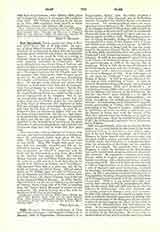

Olah (OLAHUS), NICOLAUS, Archbishop of Gran and Primate of Hungary, a distinguished prelate, b. January 10, 1493, at Nagyszeben (Hermanstadt); d. at
Nagyszombat, January 15, 1568. His father, Stephen, a brother-in-law of John Hunyadi, was of Wallachian descent; his mother was Barbara Huszar (also known as Csaszar). His autobiographical notes and correspondence throw light on his life. After having studied at the Chapter School of Varad from 1505 to 1512, he became a page at the court of Wladislaw II, but shortly afterwards chose an ecclesiastical career, and was ordained a priest in 1516 or 1518. While acting as secretary to Georg Szatmary, Bishop of Fiinfkirchen, he was appointed a canon of that chapter, later of Gran, and 1522 became Archdeacon of Komorn. In 1526 he was made secretary to King Louis II; but was transferred to the service of Queen Maria. After the battle of Mohacs, Olah attached himself to the party of King Ferdinand I, but retained his position with the queen-dowager. In 1527 he was appointed “custos” or head of the Chapter of Stuhlweissenburg, and accompanied the queen-dowager in 1530 to the imperial diet at Augsburg. When in 1531 she became Stadtholder of the Netherlands, he went with her to Belgium, where he remained (with a brief interruption in 1539) until his return to Hungary in 1542. In the following year he was made by Ferdinand I royal chancellor and Bishop of Agram. In 1548 he became Bishop of Erlau, and in 1553 Archbishop of Gran. As such he crowned Maximilian King of Hungary, and performed the solemn obsequies (1563) over Ferdinand I. As Archbishop of Gran, Olah’s first care was to put order into the finances and property of the archdiocese. He had the “Jus Piseti” again enforced, i.e. the right of supervision over the mint at Kormoczbanya, for which surveillance the archdiocese enjoyed a large revenue. At his own expense, he redeemed the hypothecated provostship of Turocz, also the encumbered possessions of the Diocese of Neutra. Olah likewise, as Archbishop of Gran, exercised a supervision over the Diocese of Erlau, and (with the consent of the Holy See) administered the Archdiocese of Kalocsa, vacant for 20 years. After the capture of Gran by the Turks, the archiepiscopal residence was at Nagyszombat or Pozsony.
Olah was particularly active in the Counter-Reformation (q.v.); even before his elevation to the Archbishopric of Gran, he had been a very zealous opponent of the new Protestant teachings. As Primate of Hungary he threw himself with renewed energy into the great conflict, aiming especially at the purity of Catholic Faith, the restoration of ecclesiastical discipline, the reformation of the clergy, and the establishment of new schools. The mountain cities of Upper Hungary, in which the doctrines of the Reformation had made considerable progress, attracted his particular attention. He organized a visitation of the archdiocese, which he in great part conducted in person, besides convoking, with a similar intention, a number of diocesan synods. The first of these synods was held in 1560 at Nagyszombat; at its close he promulgated a code of dogmatic and moral instructions, intended for the clergy, published during that and the following year. In 1561 a provincial synod was held, likewise at Nagyszombat, to discuss the participation of the bishops of Hungary in the Council of Trent, shortly before reconvened. While it is not certain that Olah took part in that council, or that he promulgated in Hungary its decrees of 1562 and 1564, it is kncwn that he followed its deliberations with close attention and practically adopted in Hungary some of its decisions. In 1563 Olah submitted to the council a lengthy memorial, in which he urged the importance of dealing with the critical situation of the Hungarian Church and describing in strong language the efforts he had made to overcome the demoralization that had seized on the clergy. It was particularly through school-reform and the proper instruction of youth that he hoped to offset the progress of the Reformation. He restored the cathedral school at Gran, which had fallen into decay when that city was captured by the Turks; he transferred it, however, to his archiepiscopal city of Nagyszombat and confided it to the Jesuits, whom he invited to Hungary in 1561, and who, by their preaching and spiritual ministrations, profoundly influenced the religious life of the nation. Among the publications initiated by him were the “Breviarium Ecclesiae Strigoniensis” (1558), and the “Ordo et Ritus Ecclesiae Strigoniensis” (1560). The revival of the custom of ringing the Angelus was due to him. As chancellor and confidant of Ferdinand I, Olah possessed much political influence, which he exercised in the special interest of the Catholic religion. In 1562 he acted as royal Stadtholder. He was a diligent writer; his works (“Hungaria et Attila“; “Genesis filiorum Regis Ferdinandi”; “Ephemerides”, and “Brevis descriptio vitae Benedicti Zerchsky”) were edited by Kovachich, in Vol. I of the “Scriptores minores”.
A. ALDASY

